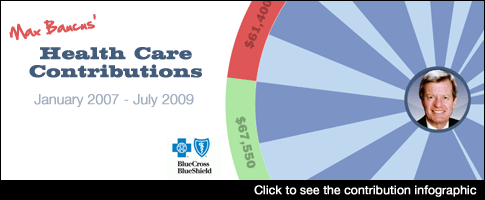Hidden ‘Bundles’ of Lobbyist Giving Show Full Court Press by Health Care Donors
Sunlight and the Center for Responsive Politics have teamed up on a collaborative investigative project that shows never-before-seen “contribution clusters” from outside lobbyists and their health care industry clients to key members of Congress.
We found that Sen. Max Baucus, D-Mont., chairman of the powerful Senate Finance Committee and author of the main health care reform bill now being debated in the Senate, was one of the biggest beneficiaries of this one-two punch from lobbyists and the interests they represent. Between January 2007 and July 2009 (the period we studied), Baucus collected contributions from 37 outside lobbyists representing PhRMA, the pharmaceutical industry’s chief trade association, and from 36 lobbyists who listed drug maker Amgen Inc. among their clients.
In all, 11 major health and insurance firms had their contributions to Baucus boosted through extra donations from 10 or more of their outside lobbyists. (See our visualization and the full list from CRP.)
Nor was Baucus alone—other members also received contributions from the employees, their family members and political action committees of health care firms and from the outside lobbyists that represented them. Senate Minority Leader Mitch McConnell, R-Ky., collected lobbyist “bundles” from 14 major health care organizations. Sen. John McCain, R-Ariz., actually led the list, with 22 organizations—though much of that money was directed at his presidential campaign last year. (see the full list.)
PhRMA and Amgen were the organizations with the most outside lobbyists chipping in with extra contributions. Some 32 members of Congress got money from 10 or more PhRMA lobbyists over the last two-and-a-half years. Amgen’s lobbyists did the same for 24 members.
There is no indication that the extra giving by lobbyists was part of a planned effort by the health care firms to solidify their support among key members of Congress. But whether coordinated or not, the newly-found clusters of lobbyist giving clearly illustrate the intensity of the full-court press that the industry is currently waging on Capitol Hill.
The research into the lobbyist-and-client giving was conducted by combining campaign contribution records with reports filed by lobbyists that identified their clients (read more on how we did it; full methodology here). The Center for Responsive Politics has been collecting that data for years, but this was the first time the two databases were combined to identify all cases where outside lobbyists contributed to the same members of Congress as their clients.
Overall, the research found that about 90 percent of the lobbyist donations were given by the lobbyists themselves. Another 10 percent came from members of their immediate families, mainly spouses. Interestingly, about one-third of the contributions were given not to the members’ campaign committees, but to their leadership PACs—separate funds that members control—but that get far less media scrutiny than their reelection campaigns. The leadership PACs also have higher contribution limits, enabling lobbyists to give well beyond the nominal $2,400 limit that applies to campaign committees.
To see Sunlight’s previous visualizations of health care lobbying–which also relied on data from the Center for Responsive Politics–click here.


